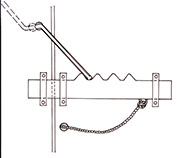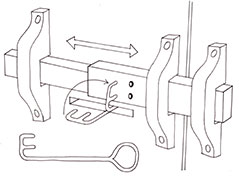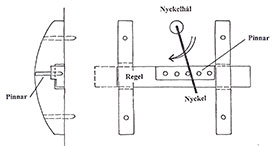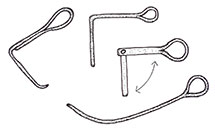Greece circa 1000 BC
The Egyptian wooden bolt lock came to Greece from one of the cultures in the Near East some time in the early Greek Middle Ages, 1100–1000 BC. The locks are called Ancient Greek or Spartan locks and may have been considered a Greek invention. The Romans adopted the concept from Greece and began making locks of metal as well.
 |
| Bronze key from the Artemis Hemera temple in Lusoi, Arcadia. The original is at the Museum of Fine Arts in Boston. Sketch by the author. |
 |
| Wooden sliding bolt lock with bronze key, circa 800 BC. Sketch by the author. |
Wooden door locks of the Spartan style
The next phase in the development of door locks was to place a beam or bolt on guides on the inside of the door, and to draw the bolt by inserting a large, angled metal key through a small opening in the door. To lock the door, a slim rope or strip of leather was used to pull the beam into the guide in the door frame. The big heavy bronze key was worn on a woman’s shoulder.
All parts of Egyptian and Greek door locks were made of hard wood. This limited the effectiveness and usability of the lock, since the wood was gradually damaged by the pressure and movement of the key. The keys were usually made of bronze and iron.
The lock to Odysseus’s treasure chamber
Since sliding bolt locks are described in Homer’s epic the Odyssey, we know that this type of lock was in use as early as the 9th century BC. Decorations on ancient vases show the use of this type of locks in Greece until the 5th century AD. Archeological digs in the south-eastern part of Europe have turned up similar bent keys in a wide range of shapes and sizes.
Roman sliding bolt locks
Roman sliding bolt locks came in different models, but all worked in more or less the same way: that a metal key with two teeth was inserted through a narrow slit in the door and matched up with two holes in the beam or bolt, which allowed it to be drawn in either direction.
 |
| Roman sliding bolt lock of wood with metal key, circa 300 AD. Sketch by the author. |
Celtic locks, type 2
The Celts used sliding bolt locks of wood that were smaller copies of the Spartan kind. They were positioned in the same way on the inside of a wall or door. They were opened by moving a bolt using an angled or bent key. The bolt could have protruding pins or holes at regular intervals on the sides, or else transverse notches or protruding catches on the top of the bolt.
Scandinavia
Door locks with sliding bolts
Sliding bolt locks consist of a single wooden bolt that slides from side to side between two holders of wood or iron. The lock was usually placed on the door or the wall next to it. On the top or side of the bolt are a few wooden or iron pins, which are accessed by an angled key of wood or iron. Sawed notches are sometimes used instead of pins.
This type of lock became increasingly common in Scandinavia during the Viking Era, and was mainly used on doors, where instead of pins they had holes or notches that matched the bits of keys with symmetrical or asymmetrical “claw” teeth, or sometimes S-shaped bits. Many local varieties of sliding bolt locks have been found on simple farm buildings throughout Scandinavia.
 |
| Sliding bolt lock on an outbuilding in Taberg, Småland, in 2005. Sketch by the author. |
The locks were placed on the inside of the wall or door. To open the door, the bolt was moved using an angled or divided, jointed key. On the side of the bolt were protruding pegs or holes at regular intervals, or else transverse notches or protruding catches on the top of the bolt.
 |
| Slide keys. Sketch by the author. |